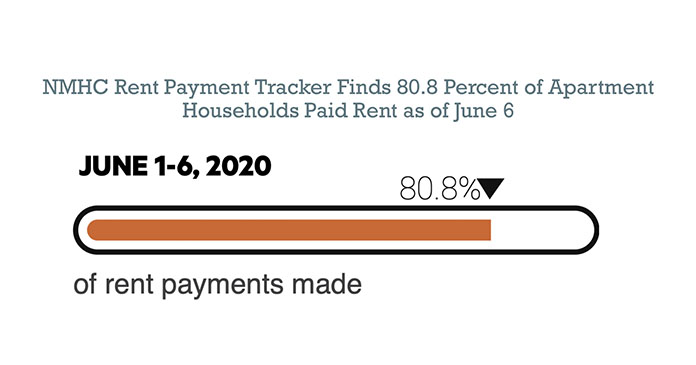The National Multifamily Housing Council (NMHC)’s Rent Payment Tracker found 80.8 percent of apartment households made a full or partial rent payment by June 6 in its survey of 11.5 million units of professionally managed apartment units across the country.
This is a 0.7-percentage point decrease in the share who paid rent through June 6, 2019 and compares to 80.2 percent that had paid by May 6, 2020. These data encompass a wide variety of professionally managed market-rate rental properties across the United States, which can vary by size, type and average rental price.
“These are trying times for the country, and we are reminded on a regular basis how crucial safe and secure housing is during a period of uncertainty and upheaval, so we are glad to see that residents who live in professionally managed properties continue to pay their rent,” said Doug Bibby, NMHC President. “While our Rent Payment Tracker metric continues to show the resilience and strength of the professionally managed apartment industry, it does not necessarily tell the whole story, as it doesn’t capture rent payments for smaller landlords or for affordable and subsidized properties, and according to Harvard, more than half of renters with at-risk wages due to the pandemic live in single-family and small multifamily rentals with 2–4 units.”
“There are serious signs of economic dislocation outside of our reporting universe that underscore the need for Congress to pass a direct rental assistance program and extend unemployment benefits before it’s too late,” said Bibby. “According to the Harvard Joint Center for Housing Studies, nearly a fifth of households with at-risk wages in small multifamily apartments may have difficulty paying rent. In addition, 32 percent of renter respondents to the Census Bureau’s Household Pulse Survey reported no or slight confidence in their ability to pay next month’s rent.”
“At the beginning of the outbreak lawmakers took swift action to extend and enhance unemployment benefits as well as create other programs aimed at keeping individuals employed. Thanks to those forward-looking steps, millions of Americans have been able to continue to be able to afford healthcare, food and shelter,” said David Schwartz, NMHC Chair, and CEO and Chairman of Chicago-based Waterton. “However, those benefits will expire on July 31. Unless policymakers move to extend them, the families and individuals relying on them will find themselves without a safety net, undercutting the initial economic recovery. We urge lawmakers in both parties to continue to sustain and support Americans as our nation and the economy begin to recover.”
The NMHC Rent Payment Tracker metric provides insight into changes in resident rent payment behavior over the course of each month, and, as the dataset ages, between months. While the tracker is intended to serve as an indicator of resident financial challenges, it is also intended to track the recovery as well, including the effectiveness of government stimulus and subsidies.
However, noteworthy technical issues may make historical comparisons imprecise. For example, factors such as varying days of the week on which data are collected; individual companies’ differing payment collection policies; shelter-in-place orders’ effects on residents’ ability to deliver payments in person or by mail; the closure of leasing offices, which may delay operators’ payment processing; and other factors can affect how and when rent data is processed and recorded.
Total unit counts may change as units are leased or vacated and survey methodology is refined.
Find more information, including the methodology, on the NMHC Rent Payment Tracker here.
The NMHC Rent Payment Tracker FAQ can be found here.












